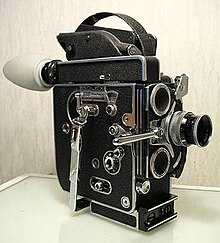Our website is made possible by displaying online advertisements to our visitors.
Please consider supporting us by disabling your ad blocker.
Documentary film

A documentary film (often described simply as a documentary) is a non-fictional motion picture intended to "document reality, primarily for instruction, education or maintaining a historical record".[1] The American author and media analyst Bill Nichols has characterized the documentary in terms of "a filmmaking practice, a cinematic tradition, and mode of audience reception [that remains] a practice without clear boundaries".[2]
Research into information gathering, as a behavior, and the sharing of knowledge, as a concept, has noted how documentary movies were preceded by the notable practice of documentary photography. This has involved the use of singular photographs to detail the complex attributes of historical events and continues to a certain degree to this day, with an example being the conflict-related photography achieved by popular figures such as Mathew Brady during the American Civil War. Documentary movies evolved from the creation of singular images in order to convey particular types of information in depth, using film as a medium.
Early documentary films, originally called "actuality films", briefly lasted for one minute or less in most cases. While faithfully depicting true events, these releases possessed no narrative structure per se and were of limited interest. Over time, documentaries have evolved to become longer in length and to include more categories of information. Some examples are explicitly educational, while others serve as observational works; docufiction movies notably include aspects of dramatic storytelling that are clearly fictional. Documentaries are informative at times, and certain types are often used within schools as a resource to teach various principles. Documentary filmmakers have a responsibility to be truthful to their vision of the world without intentionally misrepresenting a topic.
Social media organizations such as Dailymotion and YouTube, with many of these platforms receiving popular interest, have provided an avenue for the growth of documentaries as a particular film genre. Such platforms have increased the distribution area and ease-of-accessibility given the ability of online video sharing to spread to multiple audiences at once as well as to work past certain socio-political hurdles such as censorship.
- ^ "Oxford English Dictionary". oed.com. Archived from the original on 25 April 2018. Retrieved 25 April 2018.
- ^
Nichols, Bill (1998). "Foreword to the new and expanded edition". In Grant, Barry Keith; Sloniowski, Jeannette (eds.). Documenting the Documentary: Close Readings of Documentary Film and Video. Contemporary approaches to film and media series. Detroit: Wayne State University Press (published 2013). p. xiv. ISBN 9780814339725. Retrieved 6 July 2020.
Even after the word 'documentary' began to designate something that looked like a filmmaking practice, a cinematic tradition, and mode of audience reception, it remains, to this day, a practice without clear boundaries.
Previous Page Next Page


